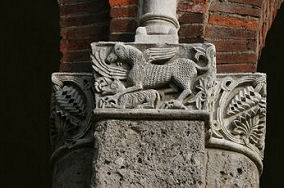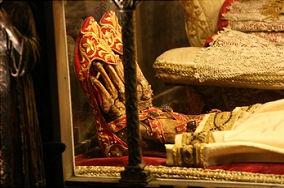|
An exceptionally
large and elaborate Gothic cathedral on the main square of Milan,
the Duomo di Milano is one of the most famous
buildings in Europe. It is the largest Gothic cathedral and the
second largest Catholic cathedral in the world: only the
cathedral of Seville is larger (St. Peter's Basilica doesn't
count because it's not a cathedral). It is 157 meters long—
40,000 people can fit comfortably within.
The Duomo occupied the most important site in the ancient Roman
city of Mediolanum. Saint Ambrose built a new
basilica on this site at the beginning of the 5th
century, with an adjoining basilica added in 836. When fire
damaged both buildings in 1075, they were rebuilt as the Duomo.
In 1386 the archbishop, Antonio da Saluzzo, began
the new project in a rayonnant Late Gothic style that is more
characteristic of France than Italy. Work proceeded for
generations. The main spire was topped in 1762 with a polychrome
statue of the Madonna, to whom the Duomo and its predecessor
have always been dedicated. Even now, some uncarved blocks
remain to be turned into sculpture. Gothic
construction on the rest of the Duomo was largely complete in
the 1880s.
The Duomo has been under major renovations and cleaning for
several years, obscuring the glorious facade with scaffolding.
Works should be completed by early 2009.
The roof climb provides a unique and memorable
opportunity to walk high on the roofs of the huge Gothic
cathedral. The views are magnificent and the opportunity to see
the pinnacles and sculptures close
up along the way is worth the climb alone.
Entrance is from the north side of the cathedral (walk around
left from the front). You can choose to walk up the stairs -
which are solid, square, and more roomy than many cathedral
stairways - or take an elevator for a higher price.
_________________________________________
|
 |
 |
|
4th-century
octagonal Baptistery of Milan |
Baptismal
font in which St. Augustine
may have
been baptized |
Beneath Milan's
Duomo lies the Battistero Paleocristiano, ruins of
a Early Christian Christian baptistery dating from
the 4th century. The excavations also include the
remains of earlier cathedrals. The Battistero is a
magnificent example of an ancient octagonal baptistery and it is
almost certainly where St. Ambrose, Bishop of
Milan, baptized St. Augustine.
Milan's first
cathedral was completed by 355 AD, when a synod was held there,
and the baptistery was almost certainly complete by then as well.
That makes it slightly newer than the Lateran Baptistery
in Rome (the oldest baptistery in Europe) and older than
the Baptistery of St. John in Poitiers (which is
the oldest Christian building in France).
St. Ambrose became bishop of Milan in 374. He is credited with
the inscription on the walls of the baptistery, which read:
Eight-niched soars this temple for sacred rites
Eight corners has its font
Right it is to build this baptismal hall about the sacred
number eight
For here the people are reborn. |
In Christian symbolism, the number eight
represents eternity and rebirth,
because the world was created in seven days and Christ rose from
the dead on the eighth day.(!) Most Early Christian baptisteries,
as well as the Church of the Holy Sepulchre in Jerusalem,
were octagonal in plan.
St. Augustine came to Milan in 384 and was
immediately impressed by the preaching of Bishop Ambrose. At
first attending sermons to admire his rhetorical skill,
Augustine was eventually moved by the message and converted to
Catholic Christianity. Ambrose baptized
Augustine and his son Adeodatus on Easter
Vigil in 387. It is very likely that this momentous event
- the baptism of one Latin Doctor of the Church by another -
took place in this baptistery.
_______________________________________
|
 |
 |
|
West
facade from the great atrium - Basilica Sant'Ambrogio |
:16th-century
Byzantine reliefs in the atrium |
The
Romanesque Basilica (11th century)
The original basilica has been excavated beneath the existing
building. Foundations indicate it had two side aisles, a
marble floor, a semicircular apse, and a four-columned
baldacchino over the high altar. The west facade has not been
located so the exact length of the nave is unknown, but it had
at least 13 bays.
It almost certainly had a large west porch on the same
foundations as the present one. If so, it was a huge complex of
more than 300 Roman feet long and 100 feet wide, larger than
contemporary basilicas in Rome.
The basilica was rebuilt in the Romanesque style in the 11th
century and this is the building that survives today. Historical
records are lacking when it comes to an exact date, but scholars
believe it was probably begun around 1080 based on the history
of architecture and engineering in Lombardy.
Historical records indicate that the old nave was still in use
in 1067 and the new one was being used by 1093. However,
it seems the westernmost bay of the nave was not completed until
the south tower was begun in 1123. The vault was probably not
built until after the earthquake of 1117. The basilica was
completed around 1128.
|
 |
 |
|
Central nave
- Sant'Ambrogio |
12th-C
ambo with 4th-C sarcophagus |
Sarcophagus
of Stilichone (4th cent.)
The Sarcophagus of Stililchone is a great treasure - not only is
it a magnificent work of early Christian art, it is one of the
few surviving elements from Ambrose's original basilica. It
still stands in the exact same place it has been since it was
carved in 385 AD - the ambo was built around it. Moreover,
it was carved during Ambrose's lifetime and its themes may have
been suggested by the bishop himself.
Crypt of St.
Ambrose
One of the most interesting sights in the Basilica of St.
Ambrose is St. Ambrose himself! He is on display in
the crypt, accompanied by St. Gervasius and
Protasius. His skeleton is glazed with a protective
coating and dressed in full bishop's finery, complete with white
mitre and dainty slippers.
The accompanying
saints are 3rd-century martyrs who were disinterred by Ambrose
for the altar of his new basilica. They originally were buried
in the nearby Chapel of Sts. Nabore and Felice (now destroyed).
The crypt was built in the late 10th century as part of major
renovations in the east end of the basilica. The great silver
urn enclosing the relics dates from 1897.
|
 |
 |
|
Feet of St.
Gervasius or Protasius, 3rd-cent.,
martyr
buried with Ambrose |
Skeleton
of St. Ambrose - display in the crypt |
|